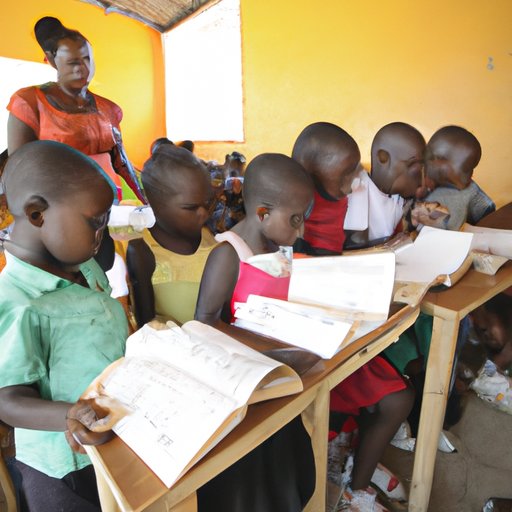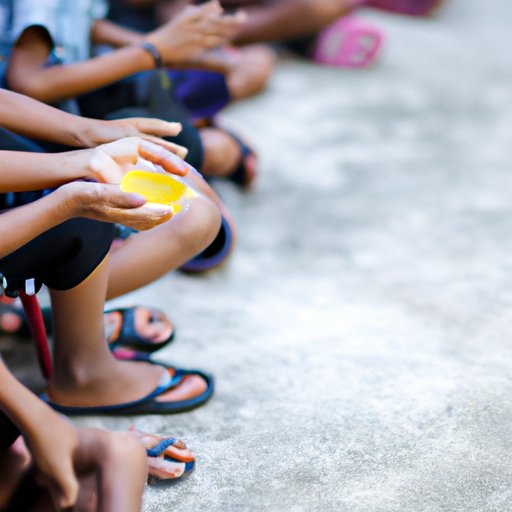Introduction
The “culture of poverty” is a concept popularized by American sociologist Oscar Lewis in the 1960s. It suggests that individuals and groups who live in poverty develop distinct values and beliefs that perpetuate their poverty status. This culture is passed down from one generation to another, resulting in a cycle of intergenerational poverty.
Today, the culture of poverty has become an increasingly relevant issue as income inequality continues to grow, particularly in developing countries. The World Bank estimates that 736 million people are living in extreme poverty, which is defined as living on less than $1.90 per day. In order to effectively tackle global poverty, it is essential to understand the underlying causes of poverty and the impact of the culture of poverty on society.

Analyzing the Root Causes of Poverty: Exploring the Culture of Poverty
In order to understand the culture of poverty, it is important to analyze the root causes of poverty. There are several factors that contribute to poverty, including historical background, structural inequalities, and social exclusion.
Historical Background
The history of colonialism and imperialism has had a lasting impact on poverty around the world. According to Dr. Mahmood Mamdani, professor of Government at Harvard University, “Poverty is not natural. It is a product of history. It is a result of deliberate policies and practices of imperial powers, both past and present.” Colonialism has resulted in political instability and economic underdevelopment in many parts of the world. For example, in Africa, colonial rule led to the exploitation of resources and the disruption of traditional systems of agriculture and trade. This has had long-term consequences for the continent, leading to high levels of poverty and inequality.
Structural Inequalities
Structural inequalities, such as gender and racial discrimination, can limit access to resources and opportunities, resulting in poverty. According to a report by UN Women, “Gender inequality is both a cause and a consequence of poverty. Women and girls face greater risks of poverty than men and boys due to unequal access to economic resources, employment opportunities, basic services, and decision-making power.” Similarly, racial discrimination has resulted in poverty for minority groups in many countries. A study by the World Bank found that “racial disparities in poverty are pervasive in most countries, with black, indigenous, and other racial minorities facing higher poverty rates than white or Asian populations.”
Social Exclusion
Social exclusion is another major factor contributing to poverty. According to the World Bank, “social exclusion occurs when individuals or groups are denied access to resources and opportunities, rights and benefits, and/or participation in decision-making processes because of their identity or circumstances.” This can be seen in marginalized communities, such as refugees and migrant workers, who often face language barriers, cultural differences, and discrimination. This can lead to poverty and lack of access to essential services and resources, perpetuating the cycle of poverty.

Examining the Impact of the Culture of Poverty on Society
The culture of poverty has a significant impact on society. It can lead to economic disadvantage, social and cultural marginalization, and political instability.
Economic Disadvantage
The culture of poverty can lead to economic disadvantage, as individuals and groups struggle to access resources and opportunities. According to a report by Oxfam, “the poorest 20 percent of the world’s population receive only 1 percent of the total global income, while the richest 20 percent receive 77 percent.” This inequality is further compounded by the fact that the poorest countries often have the highest debt burdens, making it difficult for them to invest in development and reduce poverty.
Social and Cultural Marginalization
The culture of poverty can also lead to social and cultural marginalization. Individuals and groups living in poverty may be excluded from mainstream society and experience discrimination. They may also lack access to resources and services, such as health care, education, and employment opportunities. This can lead to feelings of isolation and low self-esteem, further exacerbating the cycle of poverty.
Political Instability
The culture of poverty can also lead to political instability. In countries with high levels of poverty, there is often a lack of trust in government institutions and a sense of disempowerment among citizens. This can lead to civil unrest and violence, making it difficult for governments to effectively address poverty and inequality.

Investigating the Role of Education in Breaking the Cycle of Poverty
Education is key to breaking the cycle of poverty. It can provide individuals and groups with the knowledge, skills, and confidence they need to access resources and opportunities. However, there are several barriers to education, particularly in developing countries.
Lack of Access to Quality Education
Many individuals and groups living in poverty lack access to quality education. This can be due to a lack of resources, such as books, computers, and qualified teachers. According to UNESCO, “more than 264 million children and youth are out of school, and millions more are attending school but not learning.” This can perpetuate the cycle of poverty, as those without access to education are unable to access resources and opportunities.
Educational Attainment Gap
There is also an educational attainment gap between the wealthiest and poorest countries. According to the World Bank, “in the poorest countries, just 3 percent of students reach the international proficiency benchmark in reading, compared to 56 percent in the wealthiest countries.” This gap is further compounded by gender inequality, as girls are less likely than boys to attend school in many parts of the world.
Addressing Barriers to Education
In order to address these barriers to education, it is essential to invest in initiatives that provide access to quality education for all. This includes investing in infrastructure, such as schools and libraries, and providing scholarships and financial assistance for students. It also involves addressing gender inequality and providing equitable access to education for marginalized groups.
Unpacking the Cycle of Intergenerational Poverty and How to End It
The culture of poverty can lead to a cycle of intergenerational poverty, as individuals and groups are unable to access resources and opportunities. This can have a lasting impact on future generations, making it difficult for them to escape poverty. In order to break this cycle, it is essential to recognize the impact of trauma and establish supportive environments.
Recognizing the Impact of Trauma
It is important to recognize the impact of trauma on individuals and groups living in poverty. According to Dr. Bruce Perry, a psychiatrist and senior fellow of the Child Trauma Academy, “trauma can have a profound effect on a person’s ability to cope with life’s challenges. It can lead to depression, anxiety, and post-traumatic stress disorder (PTSD), all of which can make it difficult for individuals to access resources and opportunities.” By recognizing the impact of trauma, we can better understand the needs of those living in poverty and provide the necessary support and resources.
Establishing Supportive Environments
In order to break the cycle of poverty, it is essential to establish supportive environments. This includes providing access to quality education and healthcare, as well as creating job opportunities and providing financial assistance. It also involves addressing discrimination and promoting inclusion, so that individuals and groups living in poverty can access resources and participate in decision-making processes.
Investing in Long-Term Solutions
Finally, it is important to invest in long-term solutions to poverty. This includes investing in initiatives that promote economic development, such as microfinance programs, vocational training programs, and community development initiatives. These initiatives can provide access to resources, create job opportunities, and build local capacity, helping to break the cycle of poverty.
Highlighting Examples of Successful Programs That Address the Culture of Poverty
There are numerous examples of successful programs that address the culture of poverty. Here are three:
Microfinance Programs
Microfinance programs provide small loans and other financial services to individuals and groups living in poverty. These programs help to empower individuals by providing access to resources and opportunities. For example, the Grameen Bank in Bangladesh provides microloans to women, enabling them to start businesses and improve their livelihoods.
Vocational Training Programs
Vocational training programs provide individuals and groups with the skills they need to find employment. These programs can provide access to resources, such as job placement services, and give individuals the confidence they need to secure employment. For example, the Youth Employment Program in Mexico provides vocational training and job placement services to young people living in poverty.
Community Development Initiatives
Community development initiatives involve working with local communities to improve access to resources and opportunities. These initiatives can provide access to healthcare, education, and other essential services, as well as create job opportunities and foster economic growth. For example, the Rural Water Supply and Sanitation Initiative in India works with local communities to improve access to clean water and sanitation services.
Conclusion
The culture of poverty is a complex issue with far-reaching consequences. In order to effectively tackle poverty, it is essential to understand the root causes and the impact of the culture of poverty on society. Investing in initiatives that provide access to quality education and resources is key to breaking the cycle of poverty. Examples of successful programs include microfinance programs, vocational training programs, and community development initiatives.
(Note: Is this article not meeting your expectations? Do you have knowledge or insights to share? Unlock new opportunities and expand your reach by joining our authors team. Click Registration to join us and share your expertise with our readers.)
